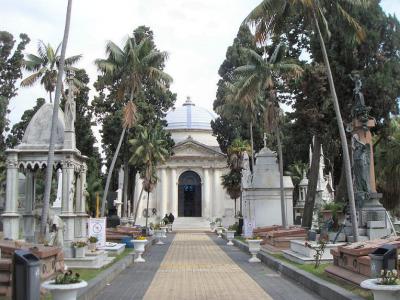
Cementerio Central (Central Cemetery), Montevideo
The Central Cemetery (Cementerio Central), situated in Montevideo is a significant historical and cultural landmark, recognized as one of the country's principal cemeteries. Since its establishment in 1835, it has become the final resting place for many of Uruguay's most distinguished individuals, which has contributed to its status as one of the most visited cemeteries in Uruguay.
Located in the southern part of Montevideo, the cemetery was originally founded on the outskirts of the city. Its establishment, far from the urban center, was a precautionary measure against potential epidemics—a common concern of the era. However, due to the rapid expansion of Montevideo throughout the 20th century, the Cementerio Central now finds itself enveloped by the city.
The cemetery's layout was commissioned by then-president Manuel Oribe, who entrusted the design to architect Carlos Zucchi. Notably, its striking entrance was designed by Bernardo Poncini, a Ticinese architect and sculptor, after the Uruguayan Civil War. This entrance became a symbol of the cemetery's architectural and artistic significance.
The Central Cemetery became increasingly popular after 1858, serving as one of the first secular cemeteries in Uruguay at a time when the Catholic Church predominantly managed burials. This marked a significant shift in burial practices within the country. The cemetery is renowned not only for its historical relevance but also for its artistic heritage. It houses various sculptures and mausoleums crafted by notable artists like José Belloni and José Luis Zorrilla de San Martín, making it a place of interest not only for its historical and cultural value but also for its artistic contributions.
Located in the southern part of Montevideo, the cemetery was originally founded on the outskirts of the city. Its establishment, far from the urban center, was a precautionary measure against potential epidemics—a common concern of the era. However, due to the rapid expansion of Montevideo throughout the 20th century, the Cementerio Central now finds itself enveloped by the city.
The cemetery's layout was commissioned by then-president Manuel Oribe, who entrusted the design to architect Carlos Zucchi. Notably, its striking entrance was designed by Bernardo Poncini, a Ticinese architect and sculptor, after the Uruguayan Civil War. This entrance became a symbol of the cemetery's architectural and artistic significance.
The Central Cemetery became increasingly popular after 1858, serving as one of the first secular cemeteries in Uruguay at a time when the Catholic Church predominantly managed burials. This marked a significant shift in burial practices within the country. The cemetery is renowned not only for its historical relevance but also for its artistic heritage. It houses various sculptures and mausoleums crafted by notable artists like José Belloni and José Luis Zorrilla de San Martín, making it a place of interest not only for its historical and cultural value but also for its artistic contributions.
Want to visit this sight? Check out these Self-Guided Walking Tours in Montevideo. Alternatively, you can download the mobile app "GPSmyCity: Walks in 1K+ Cities" from Apple App Store or Google Play Store. The app turns your mobile device to a personal tour guide and it works offline, so no data plan is needed when traveling abroad.
Cementerio Central (Central Cemetery) on Map






Sight Name: Cementerio Central (Central Cemetery)
Sight Location: Montevideo, Uruguay (See walking tours in Montevideo)
Sight Type: Attraction/Landmark
Sight Location: Montevideo, Uruguay (See walking tours in Montevideo)
Sight Type: Attraction/Landmark
Walking Tours in Montevideo, Uruguay
Create Your Own Walk in Montevideo
Creating your own self-guided walk in Montevideo is easy and fun. Choose the city attractions that you want to see and a walk route map will be created just for you. You can even set your hotel as the start point of the walk.
Prado District Walking Tour
A quiet, upscale barrio El Prado, in the north of Montevideo, is famous primarily for the sprawling park of the same name. Indeed, the city’s main green space, Parque del Prado is a major public venue made up of grassy fields, with the Arroyo Miguelete (Miguelete Creek) running through it, for which the neighborhood has been dubbed "the lung of the city".
Apart from the park,... view more
Tour Duration: 2 Hour(s)
Travel Distance: 3.6 Km or 2.2 Miles
Apart from the park,... view more
Tour Duration: 2 Hour(s)
Travel Distance: 3.6 Km or 2.2 Miles
Montevideo Old Town Walking Tour
In 1683, the Portuguese founded a city called Colonia do Sacramento across the bay from Buenos Aires. Field marshal Manuel da Fonseca built a fort there he called Montevieu. In 1724, the Spanish governor of Buenos Aires, one-armed Bruno Mauricio de Zabala, forced the Portuguese out and changed the name of the city.
Bruno and the Spanish settlers called their new city "Saint Philip and... view more
Tour Duration: 2 Hour(s)
Travel Distance: 2.5 Km or 1.6 Miles
Bruno and the Spanish settlers called their new city "Saint Philip and... view more
Tour Duration: 2 Hour(s)
Travel Distance: 2.5 Km or 1.6 Miles


